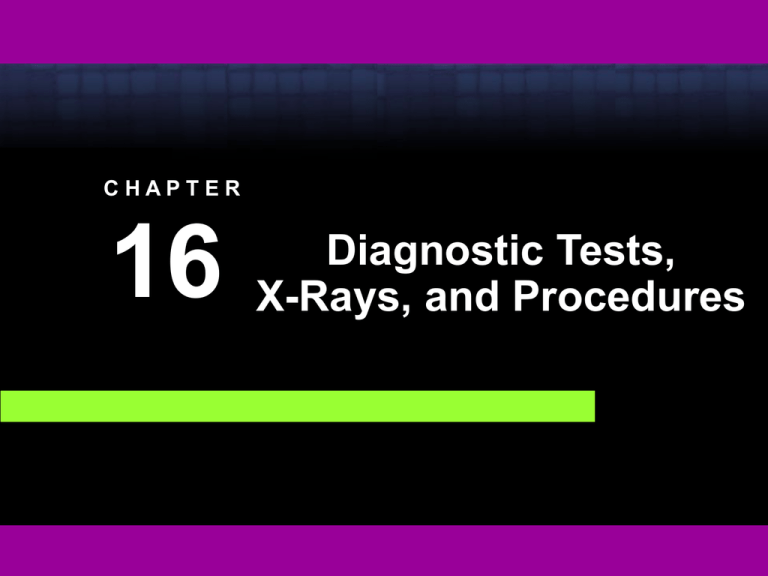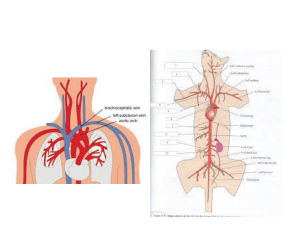
CHAPTER
16
Diagnostic Tests,
X-Rays, and Procedures
UNIT
1
Diagnostic Tests
16 - 2
Copyright © 2008 Thomson Delmar Learning, a division of Thomson Learning Inc. All rights reserved.
Scratch Skin Tests
16 - 3
Procedures commonly used to determine
allergic reactions in a patient
After “scratching” the skin, an antigen is
introduced directly to the area to induce
a reaction.
A positive reaction results in a raised
area that appears red on the skin.
(continued)
Copyright © 2008 Thomson Delmar Learning, a division of Thomson Learning Inc. All rights reserved.
Scratch Skin Tests
The most common areas used are the
arms and the back.
Make sure that the patient is comfortable
because he or she will need to stay in
this position for at least 20 minutes.
16 - 4
Copyright © 2008 Thomson Delmar Learning, a division of Thomson Learning Inc. All rights reserved.
Patch Skin Tests
The patch test is used to determine the
cause of contact dermatitis.
The suspected allergy-causing
substance is left on the surface of the
skin and the area is secured with
nonallergenic tape for 24 hours.
16 - 5
Copyright © 2008 Thomson Delmar Learning, a division of Thomson Learning Inc. All rights reserved.
Intradermal Skin Tests
Similar to the scratch test, an antigen is
inserted directly.
Though more diluted than the antigens
used for scratch testing, always be
prepared for severe reactions: have a
tourniquet and epinephrine handy.
16 - 6
Copyright © 2008 Thomson Delmar Learning, a division of Thomson Learning Inc. All rights reserved.
Administering Allergy Injections
Use an alternating pattern to help
prevent tissue damage.
16 - 7
Copyright © 2008 Thomson Delmar Learning, a division of Thomson Learning Inc. All rights reserved.
RAST Testing
RAST test is a blood test that measures
serum antibodies and can identify
individual allergens or groups of
allergens.
16 - 8
Copyright © 2008 Thomson Delmar Learning, a division of Thomson Learning Inc. All rights reserved.
Unit Summary
What is the difference between a scratch
test and a patch test?
What is the best way to be prepared if
the patient has a severe reaction to
allergy testing?
16 - 9
Copyright © 2008 Thomson Delmar Learning, a division of Thomson Learning Inc. All rights reserved.
UNIT
2
Cardiology Procedures
16 - 10
Copyright © 2008 Thomson Delmar Learning, a division of Thomson Learning Inc. All rights reserved.
Reasons to Perform an
Electrocardiogram (ECG)
Tracing the electrical activity of the heart
can help to:
Diagnose heart disease
Evaluate the condition of the heart muscle
16 - 11
Copyright © 2008 Thomson Delmar Learning, a division of Thomson Learning Inc. All rights reserved.
The Electrical Conduction
System of the Heart
16 - 12
The impulse routinely begins in the sinus
of the right atrium.
This impulse generator is called the
pacemaker or sinoatrial (SA) node.
The impulse then travels across the atria,
down the septum, and to the lining of the
ventricle.
(continued)
Copyright © 2008 Thomson Delmar Learning, a division of Thomson Learning Inc. All rights reserved.
The Electrical Conduction
System of the Heart
The impulse creates a series of peaks
and valleys on the ECG as the heart
responds.
16 - 13
Copyright © 2008 Thomson Delmar Learning, a division of Thomson Learning Inc. All rights reserved.
The Impulse Pathway
16 - 14
Copyright © 2008 Thomson Delmar Learning, a division of Thomson Learning Inc. All rights reserved.
The 12-Lead ECG
The ECG uses various points on the
chest, arms, and legs to measure the
current being produced by the heart.
16 - 15
Copyright © 2008 Thomson Delmar Learning, a division of Thomson Learning Inc. All rights reserved.
Artifacts
Artifacts are unwanted errors that appear
on the tracing.
Artifacts must be identified and then
corrected and another tracing must be
run.
16 - 16
Copyright © 2008 Thomson Delmar Learning, a division of Thomson Learning Inc. All rights reserved.
Types of Artifacts
Somatic tremor
Wandering baseline
Artifacts caused by patient movement
Artifacts caused by a loose electrode
AC interference
Artifacts caused by electrical interference
16 - 17
Copyright © 2008 Thomson Delmar Learning, a division of Thomson Learning Inc. All rights reserved.
Arrhythmias
Arrhythmias
16 - 18
Irregular rhythms produced in the heart that
appear on the tracing; they are not errors
(continued)
Copyright © 2008 Thomson Delmar Learning, a division of Thomson Learning Inc. All rights reserved.
Arrhythmias
Premature atrial contraction
16 - 19
Causes: usually stimulants such as nicotine
or caffeine
Result: cardiac cycle appears prematurely
with a different shaped P wave
(continued)
Copyright © 2008 Thomson Delmar Learning, a division of Thomson Learning Inc. All rights reserved.
Arrhythmias
Paroxysmal atrial tachycardia
16 - 20
Causes: could indicate heart disease
Rate: 160–250 BPM
Symptoms: fluttering in chest, apprehension,
shortness of breath, and dizziness
(continued)
Copyright © 2008 Thomson Delmar Learning, a division of Thomson Learning Inc. All rights reserved.
Arrhythmias
Atrial fibrillation
16 - 21
Causes: could indicate heart disease
Rate: 400–500 BPM
Result: small, irregular complexes that are
difficult to measure because the P waves
cannot be distinguished
(continued)
Copyright © 2008 Thomson Delmar Learning, a division of Thomson Learning Inc. All rights reserved.
Arrhythmias
Premature ventricular contraction
16 - 22
Causes: hypertension, coronary artery
disease, and lung disease
Results: premature beat on the tracing with
no P wave and a wide QRS complex
(continued)
Copyright © 2008 Thomson Delmar Learning, a division of Thomson Learning Inc. All rights reserved.
Arrhythmias
Ventricular tachycardia
16 - 23
Causes: acute or chronic cardiac disease
Rate: 150–250 BPM
Results: 3 or more PVCs that occur with
distorted QRS complexes and no P waves
(continued)
Copyright © 2008 Thomson Delmar Learning, a division of Thomson Learning Inc. All rights reserved.
Arrhythmias
Ventricular fibrillation
Causes: possible heart attack or heart
disease
This arrhythmia is life threatening.
Symptoms: pain in chest, PVC, or period of
ventricular tachycardia
16 - 24
Copyright © 2008 Thomson Delmar Learning, a division of Thomson Learning Inc. All rights reserved.
Mounting an Electrocardiogram
The mounting of an ECG will depend on
the machine used to record the tracing.
Single-lead ECG strips require mounting;
this will be demonstrated by the
instructor.
Multiple-lead ECG strips are already
mounted.
16 - 25
Copyright © 2008 Thomson Delmar Learning, a division of Thomson Learning Inc. All rights reserved.
The Holter Monitor
16 - 26
A portable ECG recorder is attached to
the chest of the patient to provide a 24hour recording of the electrical activity of
the heart.
This allows the physician the opportunity
to match any symptoms that occur over
the 24-hour period with the tracing.
(continued)
Copyright © 2008 Thomson Delmar Learning, a division of Thomson Learning Inc. All rights reserved.
The Holter Monitor
As an ambulatory tracing, the physician
can also monitor the function of an
artificial pacemaker and the effectiveness
of heart medications that are being taken
to control arrhythmias.
16 - 27
Copyright © 2008 Thomson Delmar Learning, a division of Thomson Learning Inc. All rights reserved.
Defibrillation
The use of electrical current to convert
cardiac arrhythmias to normal sinus
rhythms is called defibrillation.
When combined with cardiopulmonary
resuscitation (CPR), defibrillation
improves the patient’s chance of survival.
16 - 28
Copyright © 2008 Thomson Delmar Learning, a division of Thomson Learning Inc. All rights reserved.
Cardiac Stress Testing
Treadmill, or exercise tolerance ECG,
should be done routinely for patients at
high risk for heart disease.
The physician can observe the ECG
tracing and monitor the blood pressure of
the patient before, during, and after
exercise.
16 - 29
Copyright © 2008 Thomson Delmar Learning, a division of Thomson Learning Inc. All rights reserved.
Patient Education regarding
the Heart
It is especially important that patients
understand behaviors that they need to
adopt to have a healthy heart.
16 - 30
Copyright © 2008 Thomson Delmar Learning, a division of Thomson Learning Inc. All rights reserved.
Unit Summary
How do you explain somatic tremor?
What is an arrhythmia?
How do you handle artifacts in an ECG
tracing?
16 - 31
Copyright © 2008 Thomson Delmar Learning, a division of Thomson Learning Inc. All rights reserved.
UNIT
3
Diagnostic Procedures
16 - 32
Copyright © 2008 Thomson Delmar Learning, a division of Thomson Learning Inc. All rights reserved.
The Spirometry Test
16 - 33
This test evaluates the vital capacity of
the patient.
Vital capacity is the greatest volume of
air that can be expelled during a
complete, slow, unforced expiration
following a maximum inspiration.
(continued)
Copyright © 2008 Thomson Delmar Learning, a division of Thomson Learning Inc. All rights reserved.
The Spirometry Test
Vital capacity should equal inspiratory
capacity plus expiratory reserve.
This is measured using a spirometer or a
peak flow meter.
16 - 34
Copyright © 2008 Thomson Delmar Learning, a division of Thomson Learning Inc. All rights reserved.
Magnetic Resonance Imaging (MRI)
This procedure uses a strong
electromagnetic field to scan all planes of
a body structure to produce an image
processed by a computer.
Contraindication of the MRI
Patients who have permanent dental
implants or metal hardware cannot have an
MRI.
16 - 35
Copyright © 2008 Thomson Delmar Learning, a division of Thomson Learning Inc. All rights reserved.
Ultrasound
Internal structures are made visible by
recording the reflections, or echoes, of
ultrasonic sound waves directed into the
tissue.
Echocardiography examines the heart by
converting the echoes into electrical
impulses that create pictures of heart
tissue.
16 - 36
Copyright © 2008 Thomson Delmar Learning, a division of Thomson Learning Inc. All rights reserved.
Unit Summary
What is the purpose of the spirometry
test?
What should vital capacity equal?
16 - 37
Copyright © 2008 Thomson Delmar Learning, a division of Thomson Learning Inc. All rights reserved.
UNIT
4
Diagnostic
Radiological
Examinations
16 - 38
Copyright © 2008 Thomson Delmar Learning, a division of Thomson Learning Inc. All rights reserved.
Patient Preparation
The medical assistant should fully
explain the procedure to the patient.
This can demonstrate genuine caring on the
part of the medical assistant and ease the
patient’s fears and uncertainties.
16 - 39
Copyright © 2008 Thomson Delmar Learning, a division of Thomson Learning Inc. All rights reserved.
The Importance of Diet in
Preparation for X-Rays
Some diagnostic studies are designed to
show the intestinal tract and gallbladder.
In order to promote visualization, special
diets are followed to empty the intestinal
tract.
16 - 40
Copyright © 2008 Thomson Delmar Learning, a division of Thomson Learning Inc. All rights reserved.
Pregnant Women and X-Rays
Signs will be posted throughout the
department to remind all women that if
there is a possibility that they may be
pregnant, they must inform their
technician, who will discuss this with the
physician.
X-rays are contraindicated in pregnant
women.
16 - 41
Copyright © 2008 Thomson Delmar Learning, a division of Thomson Learning Inc. All rights reserved.
X-Rays That Require No Preparation
X-rays of the bones and chest do not
require any preparation.
16 - 42
Copyright © 2008 Thomson Delmar Learning, a division of Thomson Learning Inc. All rights reserved.
Patient Education and Mammography
16 - 43
The American Cancer Society recommends
x-ray examination of the breasts for all
women beginning at age 35.
This baseline study is followed with annual
mammograms after a women reaches the
age of 40.
(continued)
Copyright © 2008 Thomson Delmar Learning, a division of Thomson Learning Inc. All rights reserved.
Patient Education and Mammography
In between mammograms, women are
encouraged to perform breast selfexaminations every month to detect any
changes in the breasts very early.
Mammograms evaluate any lumps or
irregularities in the breast tissue to rule
out or diagnose breast cancer.
16 - 44
Copyright © 2008 Thomson Delmar Learning, a division of Thomson Learning Inc. All rights reserved.
Unit Summary
Why is diet important in preparing for xrays?
What x-rays require no preparation?
At what age should mammogram
screening begin?
16 - 45
Copyright © 2008 Thomson Delmar Learning, a division of Thomson Learning Inc. All rights reserved.
Keys to Career Success
By learning about diagnostic tests, the
skilled medical assistant is able to
ensure that the patient understands and
is well prepared for the examinations on
the day they are scheduled.
This also demonstrates dedication and
initiative to the employer.
16 - 46
Copyright © 2008 Thomson Delmar Learning, a division of Thomson Learning Inc. All rights reserved.
Hot Links to Career Success
www.oregonimaging.com
Oregon Imaging Centers
16 - 47
Copyright © 2008 Thomson Delmar Learning, a division of Thomson Learning Inc. All rights reserved.









